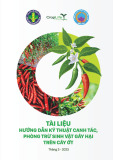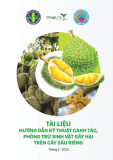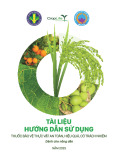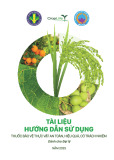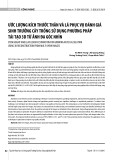
Quản lý tài nguyên & Môi trường
TẠP CHÍ KHOA HỌC VÀ CÔNG NGHỆ LÂM NGHIỆP TẬP 14, SỐ 2 (2025) 133
Bước đầu xác định thành phần loài côn trùng tại Khu Bảo tồn thiên nhiên
Mường Nhé, tỉnh Điện Biên
Lê Bảo Thanh*, Hoàng Thị Hằng, Bùi Xuân Trường, Chu Lê Vân
Trường Đại học Lâm nghiệp
The initial step to identify insect composition
in Muong Nhe Nature Reserve, Dien Bien province
Le Bao Thanh*, Hoang Thi Hang, Bui Xuan Truong, Chu Le Van
Vietnam National University of Forestry
*Corresponding author: thanhlb@vnuf.edu.vn
https://doi.org/10.55250/jo.vnuf.14.2.2025.133-139
Thông tin chung:
Ngày nhận bài: 11/12/2024
Ngày phản biện: 13/01/2025
Ngày quyết định đăng: 14/02/2025
Từ khóa:
Côn trùng quý hiếm,
Khu Bảo tồn thiên nhiên,
Mường Nhé, thành phần
côn trùng.
Keywords:
Insect composition, Muong Nhe
Commune, Nature Reserve, rare
insects.
TÓM TẮT
Bằng phương pháp điều tra thu bắt mẫu côn trùng trên các tuyến điều tra điển
hình tại Khu Bảo tồn thiên nhiên Mường Nhé, bước đầu ghi nhận 300 loài côn
trùng thuộc 59 họ của 11 bộ. Trong đó bộ Cánh vảy (Lepidoptera) có số lượng
loài nhiều nhất chiếm 72,0% tổng số loài, thấp nhất là bộ Gián (Blattoptera)
chiếm 0,33%. Sự phân bố của côn trùng chỉ mang tính tương đối và khác nhau
ở mỗi sinh cảnh, sinh cảnh rừng hỗn giao gỗ- tre nứa có số lượng loài chiếm
59,3% tổng số loài, tiếp theo là sinh cảnh rừng cây gỗ thường xanh có số lượng
loài chiếm 50,7%, sinh cảnh nương rẫy khu dân cư có số loài chiếm 38,7%, sinh
cảnh trảng cỏ cây bụi có số loài ít nhất chiếm 32,3%. Các loài côn trùng hại lá
có số lượng loài lớn nhất chiếm 80,0% tổng số loài, các loài côn trùng hại thân
cành chiếm 7,7%, các loài côn trùng hại rễ chiếm 4,7%, các loài côn trùng thụ
phấn cho thực vật chiếm 60,7% , các loài côn trùng làm thực phẩm và thuốc
chiếm 9,7%, côn trùng thiên địch chiếm 7,0%, có 2 loài côn trùng quý hiếm trong
Sách Đỏ Việt Nam 2007 và chưa xác định được vai trò có 3 loài chiếm 1% tổng
số loài.
ABSTRACT
By surveying and collecting insect samples on typical survey routes in Muong
Nhe Nature Reserve, initially, 300 insect species belonging to 59 families of 11
orders are recorded. Accounting for 72% of the overall species, the Lepidoptera
order has the largest proportion compared to the others, while the Blattoptera
order only contributes a negligible share, with 0.33%. In terms of the
distribution of insects, the data is only relative and different in each habitat;
the mixed timber-bamboo forest habitat has the biggest number of species,
accounting for 59.3% of the total number of species. It is followed by those of
evergreen timber forest and residential swidden habitats. While the former
makes up 50.7%, the latter is 12% less. Lastly, the lowest is the Blattoptera
order, with 32.3%. Leaf-damaging insects have the largest number of species,
accounting for 80.0% of the total number of species. The subsequent ranks
belong to the figures for stem-damaging insects and root-damaging insects.
The first one constitutes 7.7%, which is 3% higher than the statistics for the
second. Plant -pollinating insects occupy 60.7%, food and medicine and natural
enemy insects are 9.7% and 7.0%, respectively. There are two rare insect
species in the 2007 Vietnam Red Book. The role of 3 species is unknown,
accounting for 1% of the total species.

Quản lý tài nguyên & Môi trường
134 TẠP CHÍ KHOA HỌC VÀ CÔNG NGHỆ LÂM NGHIỆP TẬP 14, SỐ 2 (2025)
1. ĐẶT VẤN ĐỀ
Khu Bảo tồn thiên nhiên (KBTTN) Mường
Nhé được thành lập theo Quyết định số
1019/QĐ-UBND ngày 03/10/2005 của Uỷ ban
nhân dân tỉnh Điện Biên, thuộc vùng địa lý sinh
học Tây Bắc của Việt Nam với địa hình hiểm trở,
có nhiều khối núi và dãy núi cao chạy theo
hướng Tây Bắc - Đông Nam, đặc biệt là dãy
Hoàng Liên Sơn có điểm cao hơn 3.000 m.
KBTTN Mường Nhé có hệ động, thực vật rất
phong phú, tính đa dạng cao và nhiều loài quý
hiếm, giá trị bảo tồn. Các kết quả nghiên cứu tại
khu bảo tồn đã ghi nhận 976 loài thực vật bậc
cao có mạch thuộc 172 họ, 82 loài thú thuộc 25
họ, 259 loài chim thuộc 59 họ, 65 loài bò sát
thuộc 18 họ, 54 loài ếch nhái thuộc 7 họ, trong
đó có rất nhiều loài động thực vật thuộc diện
nguy cấp, quý, hiếm [1]. Côn trùng là một sinh
vật có số lượng loài lớn và có vai trò quan trọng
trong hệ sinh thái rừng, tuy nhiên cho đến nay
chưa có kết quả điều tra, nghiên cứu nào một
cách hệ thống về thành phần và phân bố của
chúng tại đây. Bài báo là tổng hợp kết quả về
thành phần loài côn trùng của một trong những
nội dung nghiên cứu của nhiệm vụ “Điều tra,
đánh giá thực trạng hệ sinh thái rừng, đa dạng
sinh học; đề xuất các giải pháp bảo tồn đa dạng
sinh học và quản lý rừng bền vững tại KBTTN
Mường Nhé, tỉnh Điện Biên, năm 2022” nhằm
bước đầu cung cấp hiện trạng côn trùng, bổ
sung cơ sở dữ liệu tài nguyên sinh vật rừng, góp
phần quản lý và phát triển tài nguyên rừng hiệu
quả và bền vững.
2. PHƯƠNG PHÁP NGHIÊN CỨU
Phương pháp xác định tuyến điều tra
Căn cứ vào điều kiện của KBTTN Mường
Nhé, tiến hành tiến hành thiết lập các tuyến
điều tra khảo sát đi qua các dạng sinh cảnh
chính: sinh cảnh rừng cây gỗ thường xanh; sinh
cảnh rừng hỗn giao gỗ - tre nứa; sinh cảnh
nương rẫy, khu dân cư; sinh cảnh trảng cỏ cây
bụi. Đặc điểm chi tiết các tuyến như Bảng 1.
Bảng 1. Đặc điểm tuyến điều tra côn trùng tại Mường Nhé
Tên tuyến
Sinh cảnh trên tuyến
Tọa độ -WGS84
(đầu-cuối)
Độ cao
(m)
Trạm Bảo vệ
rừng Sín Thầu -
bản A Pa Chải
Rừng gỗ thường xanh phục hồi; Rừng hỗn
giao gỗ-tre nứa; Trảng cây bụi. Rừng gỗ
thường xanh có trữ lượng tập trung ở gần
Trạm bảo vệ rừng và gần đỉnh A Pa Chải
0215627/2478165
-
0213938/2479012
782 - 1657
Trạm Bảo vệ
rừng Leng Su Sìn
- đỉnh mốc 54
(khoảnh 14)
Sinh cảnh Rừng gỗ thường xanh phục hồi;
Rừng gỗ thường xanh tự nhiên và Trảng cỏ
cây bụi
0227900/2472964
-
0227921/2469058
582 - 885
Trạm Bảo vệ
rừng Nậm San 1
- suối Nậm Nhé -
mốc 102
Sinh cảnh Rừng gỗ thường xanh phục hồi;
Rừng gỗ thường xanh tự nhiên, Rừng hỗn
giao gỗ-tre nứa, Nương rẫy và Trảng cây bụi
0234174/2457119
-
0230862/2450500
715 - 1425
Trạm Bảo vệ
rừng Chung
Chải - suối Nậm
Ma - Thác Rồng
Sinh cảnh Rừng hỗn giao gỗ-tre nứa; Rừng gỗ
thường xanh tự nhiên trung bình-giàu và
Trảng cây bụi
0230461/2465593
-
0224454/2462058
614 - 835
Trạm Bảo vệ
rừng Nậm Kè -
ngã ba suối
Nậm Kè
Sinh cảnh Rừng gỗ thường xanh phục hồi;
Rừng hỗn giao gỗ-tre nứa, Nương rẫy và
Trảng cây bụi
0247643/2445171
-
0245481/2445413
626 - 1016

Quản lý tài nguyên & Môi trường
TẠP CHÍ KHOA HỌC VÀ CÔNG NGHỆ LÂM NGHIỆP TẬP 14, SỐ 2 (2025) 135
Phương pháp thu mẫu, định danh và xử lý
số liệu
Mẫu vật được thu thập bằng các phương
pháp truyền thống như: bắt thủ công, vợt, bẫy
đèn, bẫy hố [2]. Định danh và xác định vai trò
của loài côn trùng bằng các tài liệu chuyên
ngành: Alexander Monastyrskii và Alexey
Devyakin (2001) [3], Mậu Bân và Trần Bội Trân
(1997), Lý Tương Đào (2006), Lý Thành Đức
(2006), Dương Hồng và Vương Xuân Hạo
(1994), Dương Tử Kỳ (2002), Phòng nghiên cứu
côn trùng (1999), Phòng nghiên cứu động vật
(1997), Từ Thiên Sâm (2004), Ngô Vân (1999),
Viện Lâm nghiệp Tây Nam (2003) [4-12].
Số liệu được xử lý bằng phần mềm thống kê
Excel, trong đó sử dụng chỉ số phong phú để xác
định độ bắt gặp hay phân bố của 1 loài. Chỉ số
này được tính theo công thức [2]:
𝑃𝑖% = 𝑛
𝑁𝑥100
Trong đó:
Pi% = Tỷ lệ điểm điều tra có loài i;
n = Tổng số điểm điều tra có loài i;
N = Tổng số điểm điều tra của toàn khu vực.
Căn cứ vào giá trị chung của Pi% để xác định
độ bắt gặp hay đặc điểm phân bố của loài theo
nguyên tắc sau đây:
Thường gặp: xxx Pi% 50%
Ít gặp: xx 25 Pi% < 50%
Ngẫu nhiên gặp: x Pi% < 25
3. KẾT QUẢ VÀ THẢO LUẬN
3.1. Thành phần các loài côn trùng tại KBTTN
Mường Nhé
Kết quả điều tra trên các tuyến điều tra đã
ghi nhận được 300 loài côn trùng thuộc 59 họ
của 11 bộ tại KBTTN Mường Nhé. Kết quả tổng
hợp số lượng loài, họvà theo bộ côn trùng được
trình bày tại Bảng 2.
Bảng 2. Thành phần côn trùng tại khu vực Khu Bảo tồn thiên nhiên Mường Nhé
TT
Tên khoa học
Tên Việt Nam
Số họ
Số loài
Số
lượng
%
Số
lượng
%
1
Odonata
Bộ Chuồn chuồn
2
3,39
4
1,33
2
Mantodea
Bộ Bọ ngựa
1
1,69
2
0,67
3
Blattoptera
Bộ Gián
1
1,69
1
0,33
4
Isoptera
Bộ Cánh bằng
2
3,39
2
0,67
5
Orthoptera
Bộ Cánh thẳng
5
8,47
14
4,67
6
Hemiptera
Bộ Cánh nửa cứng
5
8,47
8
2,67
7
Homoptera
Bộ Cánh đều
4
6,78
5
1,67
8
Coleoptera
Bộ Cánh cứng
13
22, 03
36
12,00
9
Hymenoptera
Bộ Cánh màng
3
5,08
8
2,67
10
Lepidoptera
Bộ Cánh vảy
20
33,90
216
72,00
11
Diptera
Bộ Hai cánh
3
5,08
4
1,33
Tổng
59
100
300
100
Kết quả bảng trên cho thấy trong 11 bộ côn
trùng ghi nhận được thì bộ Cánh vảy
(Lepidoptera) có số lượng loài nhiều nhất với
216 loài chiếm 72,00% tổng số loài điều tra
được, tiếp theo là bộ Cánh cứng (Coleoptera)
đã định tên được 36 loài chiếm 12,00%, bộ
Cánh thẳng (Orthoptera) có 14 loài chiếm
4,67%, bộ Cánh nửa cứng (Hemiptera) và bộ
Cánh màng (Hymenoptera) đều có 8 loài chiếm
2,67%, bộ Cánh đều (Homoptera) có 5 loài
chiếm 1,67%, thấp nhất là bộ Gián (Blattoptera)
chỉ có 1 loài chiếm 0,33%. Tại khu vực nghiên
cứu chỉ có 6 họ có số lượng loài ở mức đa dạng
cao (>15 loài) thuộc họ Papilionidae, Pieridae,
Danaidae, Satyridae, Nymphalidae, Lycaenidae
bộ Lepidoptera, Mức đa dạng khá (10-14 loài)

Quản lý tài nguyên & Môi trường
136 TẠP CHÍ KHOA HỌC VÀ CÔNG NGHỆ LÂM NGHIỆP TẬP 14, SỐ 2 (2025)
có họ Amathusiidae thuộc bộ cánh vảy
(Lepidoptera) đều có 10 loài. Số họ có số lượng
loài ở mức trung bình (5-9 loài) có 7 họ. Phần
lớn các họ ít về thành phần loài: có 45 họ, số
lượng loài ở mức thấp (< 5 loài). Kết quả điều
tra cho thấy khu hệ côn trùng tại khu vực
nghiên cứu tương đối đa dạng, thể hiện hệ sinh
thái rừng nơi đây tương đối bền vững. Tuy
nhiên, có thể thấy rằng cấu trúc thành phần các
loài, họ côn trùng đã điều tra được tại đây có
điểm không giống với cấu trúc của chúng trong
tự nhiên. Trong tự nhiên, thì bộ Cánh cứng
(Coleoptera) có số lượng loài nhiều nhất, ước
chừng hơn một triệu loài trong đó 300.000-
450.000 loài đã được mô tả. Tiếp đến là bộ
Cánh vảy (Lepidoptera) ước lượng 300.000-
500.000 loài và đã mô tả được 174.250 loài; bộ
Cánh màng (Hymenoptera) đã xác định được
115.000 loài và ước lượng trong tự nhiên có
trên 300.000 loài; bộ Cánh nửa cứng
(Hemiptera) đã mô tả được 80.000-88.000 loài
[5]. Thành phần côn trùng ghi nhận được chưa
phản ánh hết hiện trạng tài nguyên côn trùng
tại khu vực KBTTN Mường Nhé. Nhiều bộ côn
trùng không có tên trong danh sách do chưa có
điều kiện điều tra, thu thập mẫu: Đó là các bộ
côn trùng không có cánh, cư trú dưới đất, dưới
nước như Bọ đuôi bật (Collembola), bộ Hai
đuôi (Diplura), bộ Ba đuôi (Thysanura), bộ Phù
du (Ephemeroptera), bộ Cánh úp (Plecoptera)…
Tuy vậy, với số lượng loài côn trùng đã điều tra,
phát hiện được tại khu vực này cũng cho thấy
khu hệ côn trùng ở đây rất đa dạng và phong
phú. Nếu được điều tra tỷ mỉ hơn sẽ còn có thể
bổ sung nhiều loài mới cho khu vực nghiên cứu.
3.2. Sự phân bố loài côn trùng theo sinh cảnh
Sự phân bố của côn trùng chỉ mang tính
tương đối bởi các loài côn trùng có khả năng di
chuyển để tìm kiếm thức ăn và nơi cư trú. Kết
quả điều tra trên bốn dạng sinh cảnh chủ yếu
gồm: sinh cảnh rừng cây gỗ thường xanh; sinh
cảnh rừng hỗn giao gỗ - tre nứa; sinh cảnh
nương rẫy, khu dân cư; sinh cảnh trảng cỏ cây
bụi, cho thấy có sự khác nhau về thành phần
loài côn trùng ở các dạng sinh cảnh khác nhau.
Sự khác biệt rõ nhất là ở bậc phân loại loài, mức
độ khác nhau ở bậc họ không lớn, ở taxon bộ
hầu như không có sự khác nhau.
Bảng 3. Sự biến động các loài côn trùng theo các sinh cảnh
TT
Sinh cảnh
Số bộ
Số họ
Số loài
Số
lượng
%
Số
lượng
%
1
Nương rẫy, khu dân cư
10
38
64,4
116
38,7
2
Rừng cây gỗ thường xanh
11
52
88,1
152
50,7
3
Trảng cỏ cây bụi
10
31
52,5
97
32,3
4
Rừng hỗn giao gỗ- tre nứa
11
47
79,7
178
59,3
Bảng 3 cho thấy sinh cảnh Rừng hỗn giao gỗ-
tre nứa có số lượng loài nhiều nhất với 178 loài
chiếm 59,3% tổng số loài, tiếp theo là sinh cảnh
rừng cây gỗ thường xanh có số lượng loài là 152
loài chiếm 50,7%, sinh cảnh nương rẫy khu dân
cư có số loài là 116 loài, chiếm 38,7%, sinh cảnh
Trảng cỏ cây bụi có số loài ít nhất là 97 loài
chiếm 32,3%. Điều này có thể được hiểu là do
Sinh cảnh rừng hỗn giao gỗ- tre nứa là sự giao
thoa giữa rừng gỗ thường xanh và rừng tre nứa
nên có nhiều loài cây thức ăn cho các loài côn
trùng, mặt khác trong rừng hỗn giao gỗ tre nữa
cũng có nhiều khoảng trống là nơi ưa thích của
nhiều loài côn trùng cư trú và lấy thức ăn. Còn
sinh cảnh trảng cỏ cây bụi nguồn thức ăn ít nên
sự phân bố của các loài thấp.
Sự phân bố của các loài côn trùng mang tính
tương đối, và phụ thuộc rất lớn đến đặc điểm

Quản lý tài nguyên & Môi trường
TẠP CHÍ KHOA HỌC VÀ CÔNG NGHỆ LÂM NGHIỆP TẬP 14, SỐ 2 (2025) 137
sinh học của các loài, trong quá trình điều tra
thu thập cho thấy: Các loài côn trùng thuộc họ
Bướm cải (Pieridae), Bướm đốm (Danaidae)
thường gặp nhiều ở sinh cảnh ruộng nương,
khu dân cư. Tại khu vực hai bên tuyến điều tra
từ Khoan La San, Bản Tà Ko Khừ - Xã Sín Thầu,
Trạm quản lý bảo vệ rừng Sín Thầu - Mốc 24,
Trạm Quản lý bảo vệ rừng Sín Thầu - Mốc 24,
Khoảnh 7 và khoảnh 8 vào những lúc nắng
nóng, nhóm tác giả bắt gặp nhiều đàn bướm
tập trung ở các các bãi đất ẩm, các khoảng
trống. Các loài côn trùng thuộc họ Bướm rừng
(Amathusiidae) thường tập trung nhiều ở
những khu rừng rậm có nhiều cây gỗ lớn,
thường đậu trên các tảng đá nhô lên trong
rừng, đôi khi còn bắt gặp chúng ở hệ sinh thái
có cây cao và rậm rạp, thậm chí còn gặp cả
trong những khu rừng rậm có tre nứa. Các loài
côn trùng đặc trưng cho sinh cảnh khu dân cư,
nương rẫy gồm phần lớn các loài gây hại cho
thực vật, chúng bao gồm các loài cào cào, châu
chấu (Acrididae), các loài bọ rùa họ
(Coccinellidae), các loài bọ xít thuộc họ Bọ xít
mép (Coreidae), họ Bọ xít dài (Lygaeidae), họ
Bọ xít vải (Pentatomidae). Các loài dế thuộc họ
Dế mèn (Gryllidae) và họ Dế dũi
(Gryllotalpidae) hầu như chỉ thấy xuất hiện ở
khu vực này. Một số loài thuộc họ Ánh kim
(Chrysomelidae) cũng thỉnh thoảng bắt gặp ở
kiểu rừng này. Bên cạnh những loài có gây hại
thì cũng phân bố nhiều loài côn trùng ký sinh ăn
thịt, trong đó đáng chú ý là các loài thuộc họ Bọ
ngựa (Mantidea), các loài thuộc họ Hổ trùng
(Cicindelidae), họ Bọ rùa (Coccinellidae), họ Bọ
xít ăn sâu (Reduviidae), họ Ong vàng
(Vespidae), họ Muỗi (Culicidae) cũng thường
hay bắt gặp ở khu vực này. Đặc biệt khu dân cư,
cây trồng nông nghiệp là nơi chăn thả rông của
nhiều loài gia súc nên xuất hiện các loài côn
trùng phân huỷ chất thải động vật thuộc họ
Scarabaeidae. Các loài kiến (Formicidae) bắt
gặp ở tất cả các sinh cảnh tại khu vực nghiên
cứu.
3.3. Vai trò của côn trùng
Khu Bảo tồn thiên nhiên Mường Nhé với
chức năng quan trọng là nơi bảo tồn các loài
sinh vật, bảo vệ hệ sinh thái bền vững, bên cạnh
đó cũng phải đảm bảo đời sống cho người dân
địa phương, chính vì vậy Côn trùng có một vai
trò quan trọng trong hệ sinh thái tự nhiên và
đời sống con người nơi đây. Căn cứ vào đặc
điểm sinh học, sinh thái và nhu cầu sử dụng các
sản phẩm từ côn trùng mà phân chia theo các
vai trò như Hình 1.
Hình 1. Tỷ lệ % số loài của các nhóm côn trùng theo vai trò
0.0 10.0 20.0 30.0 40.0 50.0 60.0 70.0 80.0 90.0
Thiên địch
Thực phẩm, thuốc
Thụ phấn cho thực vật
Hại lá
Hại thân cành
Hại rễ
Ảnh hưởng sức khoẻ
Chưa xác định
Tỷ lệ %

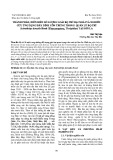
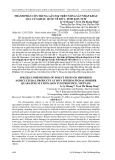


![Giáo trình Côn trùng đại cương (Nghề Bảo vệ thực vật Cao đẳng): Phần 2 - Trường Cao đẳng Cộng đồng Đồng Tháp [Mới Nhất]](https://cdn.tailieu.vn/images/document/thumbnail/2022/20220802/canhdongco25/135x160/1149732965.jpg)



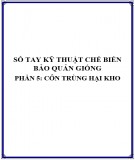
![Giáo trình Phòng trừ dịch hại Trồng trọt - Trường CĐ Cộng đồng Lào Cai [Mới nhất]](https://cdn.tailieu.vn/images/document/thumbnail/2021/20210713/chuheodethuong25/135x160/601626172447.jpg)




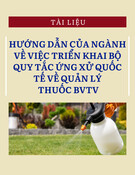
![Tài liệu Quản lý sâu bệnh hại chính trên nhãn, xoài tại Sơn La [mới nhất]](https://cdn.tailieu.vn/images/document/thumbnail/2025/20250908/kimphuong1001/135x160/621757323949.jpg)
![Hướng dẫn an toàn phun thuốc BVTV bằng thiết bị bay không người lái (UAV/Drone) tại Việt Nam [Tài liệu]](https://cdn.tailieu.vn/images/document/thumbnail/2025/20250908/kimphuong1001/135x160/9771757324045.jpg)
